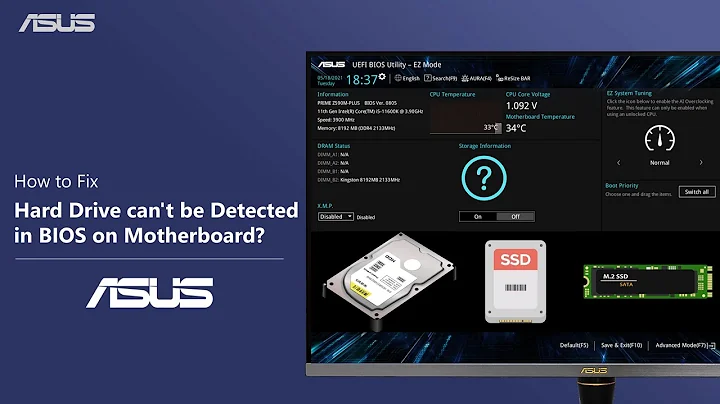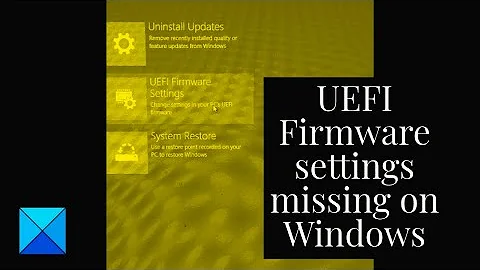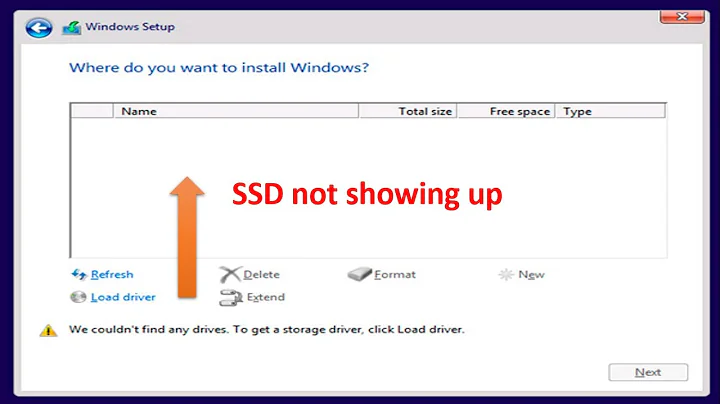SATA Devices not showing up when in UEFI mode
Solution 1
I wonder, is the windows image efi bootable? If the image is not efi bootable you can only boot it using legacy. This goes at least for USBs, and I would assume it does the same with CDs. You can check this by seeing if the file 'BOOTX64.EFI' via the path \EFI\BOOT\ is available on the CD.
Also, is it a must for you to install it with this CD? If not, you could try install windows by using a bootable USB, to make sure that the drive is GPT. If you already have a windows machine and a USB device available you can simply use a windows ISO, and use the program rufus to create a bootable usb. Otherwise, maybe this can be of any help?
Solution 2
When booting the Windows 7 installation DVD you get the message :
"Windows cannot be installed to this disk. The selected disk is of the GPT partition style."
So the disk is already GPT (why if it's only 1TB?).
However, installing Windows 7 64-bit on GPT can only be done in UEFI mode.
Conclusion: Either your Windows 7 DVD isn't 64-bit or your BIOS doesn't support UEFI well-enough.
What you can do is :
- Verify that the Windows 7 installation DVD is the latest 64-bit version with SP1
and try again.
Delete all existing partitions, create a new one and format it. - Convert the disk to MBR using Linux. See the article
How to Convert a GPT disk layout to a MS-DOS/MBR layout without data loss.
You might be able to convert the disk to MBR from the Windows 7 installation disk:
Method 1 (non-destructive in theory)
- Boot up to installation DVD/CD.
- Click install but don't follow through.
- Press SHIFT-F10 to bring up console.
- Type "diskpart"
- Once inside diskpart type:
-> list disk (find the one you want to convert)
-> select disk 0 (select the one you want from the list)
-> convert mbr (should take a second or two)
-> quit - Continue with install
Method 2 (destructive)
- Boot up to installation DVD/CD.
- Click install but don't follow through.
- Press SHIFT-F10 to bring up console.
- Type "diskpart"
- Once inside diskpart type:
-> list disk (find the one you want to convert)
-> select disk 0 (select the one you want from the list)
-> clean (wait an hour or so until done)
-> quit - Continue with install
Method 3 : GParted (destructive)
- Launch GParted on the disk.
- If any partitions are mounted (as indicated by a lock or key icon), unmount them.
- Select Device -> Create Partition Table.
- Click Apply.
The disk should now use MBR. Do not create partitions within GParted, do this instead with the Windows installer.
Just remember that any such manipulation can destroy the data on the disk.
Solution 3
Try changing the SATA devices (or just the optical drive) from AHCI mode to whatever legacy/compatibility mode is available there, leaving the BIOS in UEFI mode and see if that changes anything.
Solution 4
Change your SATA to ACHI in BIOS. That did the trick for me.
Related videos on Youtube
Comments
-
Dan Barzilay over 1 year
I'm trying to install Windows and the bios should be set to UEFI mode. The problem is that all SATA devices aren't showing up (shows as if there aren't any) so I can't boot from the installation CD (it's just not there).
The weird thing is that when set to LEGACY mode they all show up..
SATA mode is set to AHCI and I'm on Lenovo Y510P. I have a Linux OS installed that is accessible only when BIOS is in LEGACY mode (otherwise the hard drive it's on is not available)
I also tried reseting the BIOS settings which didn't help..
Comment please if more details needed
Extra details:
- Computer model: Lenovo IdeaPad Y510P (not overcloacked)
- Installed Linux OS version: Linux 3.7-trunk-amd64 x86_64
- Trying to install Windows: Windows 7 Ultimate 64bit
-
BIOS Information:
- Vendor: LENOVO
- Version: 74CN26WW(V1.07)
Update:
Using user1608638 answer and suggestion of using the USB flash drive as the boot device instead of the CD/DVD method I succeeded in installing Windows 7! (Thanks alot user1608638)
-
 Admin about 10 yearsSee if Linux can see the disks. Try also to find a BIOS update (self-booting if there is no OS at all). It's hard to be precise without more info about your setup.
Admin about 10 yearsSee if Linux can see the disks. Try also to find a BIOS update (self-booting if there is no OS at all). It's hard to be precise without more info about your setup. -
 Admin about 10 yearsI can't use Linux Live CD while in UEFI mode because the CD reader drive is not available. I forgot to mention that I have a Linux OS installed which works great in Legacy mode but again, not available in UEFI because the hard drive it's on is not available (available = showing up). What further details would you like to know about my setup?
Admin about 10 yearsI can't use Linux Live CD while in UEFI mode because the CD reader drive is not available. I forgot to mention that I have a Linux OS installed which works great in Legacy mode but again, not available in UEFI because the hard drive it's on is not available (available = showing up). What further details would you like to know about my setup? -
 Admin about 10 yearsLenovo site claims that there are currently no BIOS updates ( support.lenovo.com/en_IL/downloads/detail.page?DocID=DS035829 )
Admin about 10 yearsLenovo site claims that there are currently no BIOS updates ( support.lenovo.com/en_IL/downloads/detail.page?DocID=DS035829 ) -
 Admin about 10 yearsI would like the involved computer model, disk(s) model, BIOS version, Linux version, Windows version (I assume 64-bit). You can boot Linux also from USB, but if Linux is working you could use gdisk to convert the disk to GPT (disk lose possible). Note that Windows might not like a mix of MBR and GPT inner hard disks.
Admin about 10 yearsI would like the involved computer model, disk(s) model, BIOS version, Linux version, Windows version (I assume 64-bit). You can boot Linux also from USB, but if Linux is working you could use gdisk to convert the disk to GPT (disk lose possible). Note that Windows might not like a mix of MBR and GPT inner hard disks. -
 Admin about 10 years@harrymc I edited the answer with all the extra details, can you please expand on what you suggested with GPT? (I don't know what's that). Thanks for helping me
Admin about 10 years@harrymc I edited the answer with all the extra details, can you please expand on what you suggested with GPT? (I don't know what's that). Thanks for helping me -
 Admin about 10 yearsAre you using UEFI with secure boot?
Admin about 10 yearsAre you using UEFI with secure boot? -
 Admin about 10 years@CristianCiupitu secure boot is disabled.
Admin about 10 years@CristianCiupitu secure boot is disabled. -
 Admin about 10 yearsConverting the disk to GPT might help (or not), but most probably will make it unusable without reformatting, so try everything else before that. What happens if you try to boot Windows in Legacy mode and are you doing it via USB boot?
Admin about 10 yearsConverting the disk to GPT might help (or not), but most probably will make it unusable without reformatting, so try everything else before that. What happens if you try to boot Windows in Legacy mode and are you doing it via USB boot? -
 Admin about 10 years@harrymc if I try to boot Windows installation CD (not USB, but probably will be the same result) in Legacy mode than it says: "Windows cannot be installed to this disk. The selected disk is of the GPT partition style."
Admin about 10 years@harrymc if I try to boot Windows installation CD (not USB, but probably will be the same result) in Legacy mode than it says: "Windows cannot be installed to this disk. The selected disk is of the GPT partition style."
-
Dan Barzilay about 10 yearsTried that (the other mode is called Legacy) - not working.
-
 harrymc about 10 yearsThe other explanation is that the Windows boot DVD doesn't have a driver for the hard disk. The Lenovo specs for Y510p don't specify the disk type, except to say that there are 3 possibilities. In that case you will need to either supply the driver during boot or slipstream it into the boot media. Lenovo Support has a driver for Intel Rapid Storage Technology for Windows 7.
harrymc about 10 yearsThe other explanation is that the Windows boot DVD doesn't have a driver for the hard disk. The Lenovo specs for Y510p don't specify the disk type, except to say that there are 3 possibilities. In that case you will need to either supply the driver during boot or slipstream it into the boot media. Lenovo Support has a driver for Intel Rapid Storage Technology for Windows 7. -
Dan Barzilay about 10 yearsI might have not clarified it enough - the drives not showing up - that's in the boot menu, not when trying to install Windows; I can't even try to install it while in UEFI mode because there are no drives in the boot menu to boot from. When I change the BIOS to Legacy mode I can see the drives in the boot menu and therefor boot the installation CD - at that point the installation disk does show the drives but with the GPT error which you gave a suggestion on how to solve. My main question though, is how to fix that the boot menu shows no drives while the BIOS is in UEFI mode.
-
 harrymc about 10 yearsThat's a problem of the BIOS not supporting 64-bit in UEFI mode. I don't think anyone except Lenovo can fix that. You could try and contact their Support - they might have a secret BIOS update or parameter. Otherwise, converting to MBR is the only advice that I can think of.
harrymc about 10 yearsThat's a problem of the BIOS not supporting 64-bit in UEFI mode. I don't think anyone except Lenovo can fix that. You could try and contact their Support - they might have a secret BIOS update or parameter. Otherwise, converting to MBR is the only advice that I can think of. -
Pacerier about 9 years@user1608638, Is it possible to solve it then, by copy/pasting the required EFI folder and files in? E.g. per iplanetforum.com/…
-
 I say Reinstate Monica over 6 yearsWelcome to Super User! Please edit your post to include the essential elements of the linked material. Good answers include specific instructions (not just links to them) and an explanation as to how/why the answer addresses the OPs question.
I say Reinstate Monica over 6 yearsWelcome to Super User! Please edit your post to include the essential elements of the linked material. Good answers include specific instructions (not just links to them) and an explanation as to how/why the answer addresses the OPs question. -
mic84 over 5 yearsWelcome to Superuser:- Your answer to a question that has an accepted answer will need some more detail to be supported by readers. How do you change the SATA etc, what systems are you using etc. Your answer can be useful to other readers that the accepted answer did not work for but requires detail. Please take a couple of minutes and read:- help center .Answering: How to Answer, again welcome to superuser and i hope you keep coming back.Thankyou




